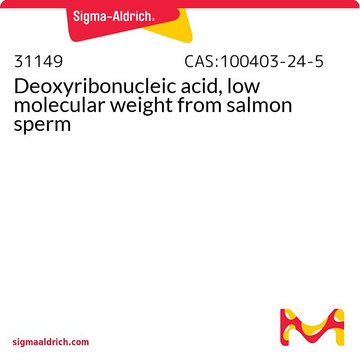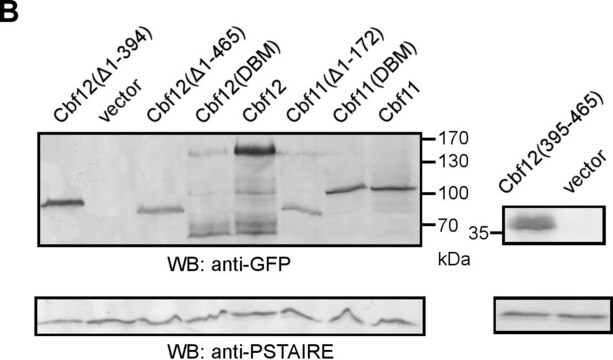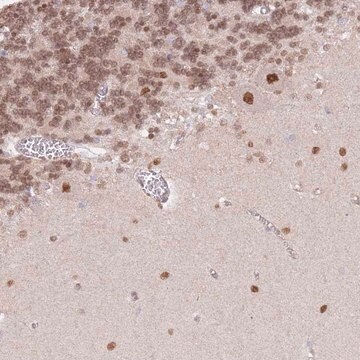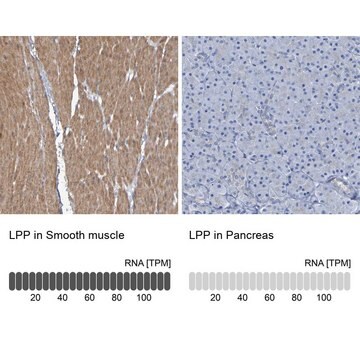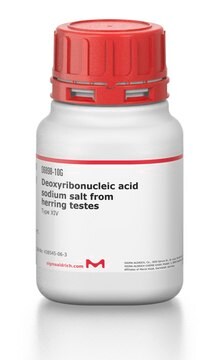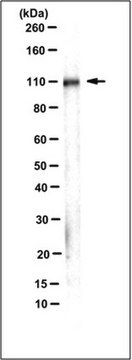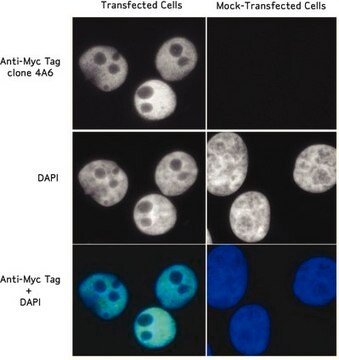MAB1676-C
Anti-Talin 1 Antibody, clone TA205, N-Term, Ascites Free
clone TA205, from mouse
Synonym(s):
Talin-1
About This Item
IHC
IP
WB
inhibition assay
immunohistochemistry: suitable (paraffin)
immunoprecipitation (IP): suitable
inhibition assay: suitable
western blot: suitable
Recommended Products
biological source
mouse
Quality Level
antibody form
purified antibody
antibody product type
primary antibodies
clone
TA205, monoclonal
species reactivity
human
species reactivity (predicted by homology)
rabbit (based on 100% sequence homology)
technique(s)
immunofluorescence: suitable
immunohistochemistry: suitable (paraffin)
immunoprecipitation (IP): suitable
inhibition assay: suitable
western blot: suitable
isotype
IgG1κ
NCBI accession no.
UniProt accession no.
shipped in
wet ice
target post-translational modification
unmodified
Gene Information
human ... TLN1(7094)
General description
Immunogen
Application
Immunohistochemistry Analysis: A representative lot detected Talin 1 in MeOH fixed fibroblasts.
Inhibition Analysis: A representative lot from an independent laboratory disrupts actin stress fibers and focal adhesions, and inhibits cell motility when microinjected into human fibroblasts (Bolton, S. J., et al. (1997). Cell Motil Cytoskeleton. 36(4): 363-376.).
Immunoprecipitation Analysis: A representative lot from an independent laboratory immunoprecipitated Talin 1 from shCTRL and shLRP-1-c1 carcinoma cell lysates (Dedieu, S., et al. (2008). Mol Cell Biol. 28(9):2980-2995.).
Immunoprecipitation Analysis: A representative lot from an independent laboratory immunoprecipitated Talin 1 from shCTRL and shLRP-1 cell lysates (Langlois, B., et al. (2010). PLoS One. 5(7):e11584.).
Immunoprecipitation/Western Blotting Analysis: A representative lot from an independent laboratory immunoprecipitated Talin 1 from PC3-2 cell lysates. Immunoprecipitated Talin 1 was then detected in Western Blotting (Trerotola, M. et al. (2012). J Cell Physiol. 227(11): 3670-3676.).
Immunofluorescence Analysis: A representative lot from an independent laboratory detected Talin 1 in macrophages (Love, D. C., et al. (1998). Exp Parasitol. 88(3):161-171.).
Immunofluorescence Analysis: A representative lot from an independent laboratory determined that the level of disruption in talin-containing focal complexes is inhibited in LRP-1-silenced carcinoma cells (Dedieu, S., et al. (2008). Mol Cell Biol. 28(9):2980-2995.).
Immunofluorescence Analysis: A representative lot from an independent laboratory detected Talin-1 in shCTRL and shLRP-1 transfected cells (Langlois, B., et al. (2010). PLoS One. 5(7):e11584.).
Cell Structure
Cytoskeleton
Quality
Western Blotting Analysis: 1 µg/mL of this antibody detected Talin 1 in 10 µg of HeLa cell lysate.
Target description
Physical form
Storage and Stability
Handling Recommendations: Upon receipt and prior to removing the cap, centrifuge the vial and gently mix the solution. Aliquot into microcentrifuge tubes and store at -20°C. Avoid repeated freeze/thaw cycles, which may damage IgG and affect product performance.
Other Notes
Disclaimer
Not finding the right product?
Try our Product Selector Tool.
recommended
Storage Class Code
12 - Non Combustible Liquids
WGK
WGK 2
Flash Point(F)
Not applicable
Flash Point(C)
Not applicable
Certificates of Analysis (COA)
Search for Certificates of Analysis (COA) by entering the products Lot/Batch Number. Lot and Batch Numbers can be found on a product’s label following the words ‘Lot’ or ‘Batch’.
Already Own This Product?
Find documentation for the products that you have recently purchased in the Document Library.
Our team of scientists has experience in all areas of research including Life Science, Material Science, Chemical Synthesis, Chromatography, Analytical and many others.
Contact Technical Service